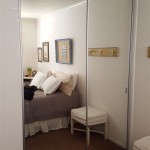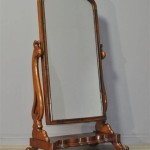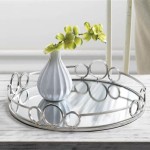Best Ways to Hang a Mirror on a Door
Hanging a mirror on a door can be a practical and space-saving solution for various needs, from providing a full-length reflection in a bedroom to creating a final check-point before leaving the house. The process, however, requires careful planning and execution to ensure the mirror is securely mounted and does not damage the door. There are several methods available, each with its own set of advantages and disadvantages, considerations, and suitability for different types of doors and mirrors. The optimal approach depends on factors such as the mirror's weight, the door's material, and the desired level of permanence.
Before proceeding with any method, it is crucial to gather the necessary tools and materials. This commonly includes a measuring tape, a level, a pencil, a drill (if required), appropriate hanging hardware (such as over-the-door hooks, adhesive strips, or mounting brackets), a screwdriver, and safety glasses. A thorough review of manufacturer’s instructions for any hardware being used is advisable. Furthermore, it is recommended to clean both the back of the mirror and the door surface with a suitable cleaning solution to ensure proper adhesion for methods relying on adhesives.
Selecting the Appropriate Hanging Method
Choosing the right hanging method is paramount to ensuring the mirror stays securely in place and avoids causing damage to the door. Several factors should be considered during this selection process, including the weight of the mirror, the type of door material, and the desired aesthetic.
Over-the-door hooks offer a non-permanent and relatively straightforward solution. These hooks typically hang over the top edge of the door and provide a place to suspend the mirror. This method is particularly suitable for lightweight mirrors and doors made of solid materials like wood. However, it is important to verify that the hooks fit snugly on the door to prevent the mirror from swinging excessively or potentially damaging the door frame. The weight capacity of the hooks should also be carefully considered to avoid overloading them.
Adhesive strips, often marketed as "mirror hanging strips," provide another option for attaching a mirror to a door. These strips are designed to create a strong bond between the mirror and the door surface. This method is generally best suited for lighter mirrors, and its success hinges on proper surface preparation. The door and the back of the mirror must be thoroughly cleaned and dried before applying the adhesive strips. It is essential to use strips specifically designed for mirror hanging, as standard adhesive strips may not provide sufficient holding power or may damage the mirror backing. Furthermore, it is crucial to follow the manufacturer's instructions regarding the number of strips required based on the mirror's weight and size. The positioning of the strips is also critical for even weight distribution.
Mounting brackets offer a more secure and permanent solution for hanging a mirror on a door. This method involves attaching brackets to the door using screws and then securing the mirror to the brackets. This approach is particularly well-suited for heavier mirrors and doors made of sturdy materials. However, it requires drilling into the door, which can be undesirable for some individuals or in certain situations. Careful measurement and pilot drilling are essential to ensure the brackets are properly aligned and the screws do not damage the door. Furthermore, the selection of appropriate screws is important to prevent them from protruding through the other side of the door or stripping the screw holes.
Regardless of the chosen method, it is crucial to consider the thickness of the door. If using screws, they must be short enough to avoid penetrating completely through the door. Similarly, over-the-door hooks should fit securely without causing the door to bind in the frame. Accurate measurement and careful consideration of the door's dimensions are essential for a successful installation.
Step-by-Step Guide to Hanging a Mirror Using Over-the-Door Hooks
The following outlines the process for hanging a mirror using over-the-door hooks. This is generally the simplest and least invasive method, making it a popular choice for many applications.
First, the appropriate over-the-door hooks must be selected. These should be specifically designed for hanging mirrors and possess a weight capacity that exceeds the mirror's actual weight. It is prudent to choose hooks with padding or a protective coating on the contact points to prevent scratching or damaging the door's surface. Inspect the hooks for any defects or imperfections before proceeding.
Next, the desired location for the mirror on the door should be determined. Use a measuring tape and a level to mark the desired height and ensure the mirror will be hung straight. It is often helpful to have a second person assist with this step to provide visual confirmation and ensure the mirror's positioning is satisfactory.
Once the location is marked, carefully hang the over-the-door hooks on the top edge of the door, aligning them with the marked points. Ensure the hooks are securely seated and do not wobble or shift easily. If necessary, adjust the hooks' position to ensure they are properly aligned and the mirror will hang straight.
Finally, carefully lift the mirror and hang it on the hooks. Ensure the mirror is securely attached and that the weight is evenly distributed. Step back and visually inspect the mirror to confirm it is hanging straight. If necessary, make minor adjustments to the hooks' position or the mirror's placement to achieve the desired alignment.
After the mirror is hung, it is advisable to periodically check the hooks to ensure they remain securely attached and the mirror is not at risk of falling. If any signs of loosening or instability are observed, the hooks should be tightened or replaced as necessary.
Using Adhesive Strips for Mirror Installation
Utilizing adhesive strips for mirror installation offers a less intrusive alternative to drilling, but requires meticulous surface preparation and adherence to manufacturer guidelines.
The first step involves cleaning both the back of the mirror and the corresponding area on the door. Use a clean cloth and a degreasing cleaner to remove any dirt, dust, or residue. Allow both surfaces to dry completely before proceeding, as moisture can compromise the adhesive bond. Isopropyl alcohol can be used if a degreasing cleaner is unavailable.
Next, carefully apply the adhesive strips to the back of the mirror. The instructions on the packaging of the chosen adhesive strips should be followed precisely. Generally, strips should be positioned evenly across the mirror's surface to distribute the weight evenly. Press each strip firmly onto the mirror to ensure a strong initial bond. Avoid touching the adhesive surface with fingers, as this can reduce its effectiveness. For larger mirrors, consider applying a greater number of strips for added security.
Once the adhesive strips are in place, carefully position the mirror on the door, aligning it with the desired location. This is a crucial step, as repositioning the mirror after it has been attached can be difficult and may damage the door or the mirror. Use a level to ensure the mirror is hanging straight before fully pressing it against the door.
Apply firm and even pressure to the mirror for the recommended duration specified by the adhesive strip manufacturer. This pressure helps to create a strong and lasting bond between the adhesive strips and the door surface. It is often recommended to use a roller to apply even pressure across the entire mirror surface. Avoid applying excessive pressure, as this could damage the mirror.
It is advisable to avoid putting strain on the adhesive bond for at least 24 hours after installation. This allows the adhesive to fully cure and achieve its maximum strength. During this period, avoid touching or moving the mirror. After the curing period, gently test the mirror's stability. If any signs of weakness or instability are observed, consider adding additional adhesive strips or using an alternative hanging method. Periodic checks of the adhesive bond are also recommended to ensure the mirror remains securely attached.
Selecting the right method for hanging a mirror on a door involves carefully considering the mirror’s weight, the type of door, and the desired level of permanence. Proper execution and attention to detail are crucial for a successful and safe installation.

3 Ways To Hang A Door Mirror Wikihow

3 Ways To Hang A Door Mirror Wikihow

3 Ways To Hang A Door Mirror Wikihow

3 Ways To Hang A Door Mirror Wikihow

3 Ways To Hang A Door Mirror Wikihow

Over The Door Hanging Mirrors A Comprehensive Guide

Saving Space And Gaining Style With Over The Door Mirrors

Over The Door Hanging Mirrors A Comprehensive Guide

Over The Door Hanging Mirrors A Comprehensive Guide

3 Ways To Hang A Door Mirror Wikihow








